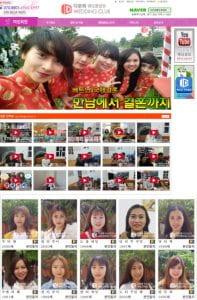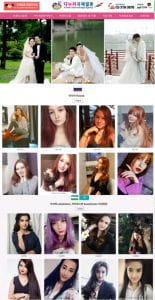By Minjae Shin
‘Getting married to Vietnamese/China/Philippines/Uzbekistan woman – If for any reason you’re not satisfied with our service, a 100% satisfaction guarantee.’
This eye-catching phrase is from the website of international marriage brokers in South Korea. My research journey started with this advertisement. Until a few decades ago, the segment of marriage migration that was supported by the marriage industry drew little notice in East Asia. As a result of rapid economic development in Asian countries such as South Korea, Singapore and Taiwan, marriage migration patterns have shifted. This economic growth has turned these countries into new marriage destination countries, largely for women from developing countries also in Asia. Indeed, there has been a steep increase in immigration by way of marriage into Korea since the 1990s, as cross-border marriages between Korean men and migrant women became increasingly prominent in the country. In Korea, the so-called marriage squeeze phenomenon – the imbalanced sex ratio among the marriageable population – has resulted in a shortage of prospective Korean brides. Rural bachelors were the first to face this ‘bride shortage’ problem (Friedman and Mahdavi, 2015). Men who live in the less economically lucrative rural areas often work the land and are considered unmarriageable as Korea’s history of economic development privileges the urban over the rural. As a result, Korean authorities, from the central government to local governments, have begun to encourage cross-border marriages for wife-seeking rural bachelors as a national project, named the ‘Rural Bachelor Marriage Project’, in order to address the problem of shortages in the labour force in rural areas from the early 1990s onwards.

Most of the marriage migrants in Korea are women, who account for 83% of the country’s total number of marriage migrants (132,391 out of 159,206). In the early 1990s, these migrant wives were predominantly ethnic Koreans from China. The countries of origin of these women have since diversified to include Vietnam, the Philippines and countries in Central Asia and Eastern and Central Europe. Currently, cross-border marriage is prominent even in urban areas, and it has become an important pathway to marriage for Korean men who are of a lower socio-economic status, and not solely for rural men.
At the centre of this marital migration exists international marriage brokers. Cross-border marriage in Korea has become increasingly commoditised and systematised, with the rapid growth of the profit-oriented marriage brokerage industry. In Korea, a high percentage of marriage migrants (84.3%) met their spouses through marriage brokerage agencies, highlighting the prominent role of these agencies in marriage migration to Korea. In contrast to commercially brokered cross-border marriages in other parts of the world, most marriage brokers in Korea do not provide email correspondence services due to the language limitations of their clients who hardly know the language of their potential partners. These agencies must operate as the mediator, serving as the go-between for the two potential spouses. They closely interact with potential spouses both in Korea and overseas who seek cross-border marriages and assist both by providing information on criteria, legal procedures and immigration policies to their clients. The agencies also provide information about the cultural and national background of a potential spouse, the women’s expectations about the marriage (for example, love, or a better life). The agencies then communicate this information to their male clients. Moreover, with the advancement of the Internet, marriage brokers provide their male clients with profiles and photographs of their potential spouses to choose from.
In these processes, the practices of marriage brokers tend to be problematic, specifically with respect to their representation of migrant women. Racialised and gendered representations are readily apparent, in particular in their advertisements and marketing strategies. Marriage brokers claim that they speak for migrant women who are searching for a better life to escape poverty in their countries. Yet, at the same time, they tend to depict migrant women as ‘naïve, pure, innocent, submissive, obedient and thrifty, or non-materialist’. They also tend to emphasise the different appearances of women from different countries by using the phrase ‘the strength of women’. For example, on their websites, they illuminate the strengths of Southeast Asian women by stressing similar appearances with Korean; on the other hand, the strengths of Central Asian women by stressing exotic westernised beauty. The women who migrated to Korea through marriage are thus homogenised, their individuality obliterated by ignoring their uniqueness and differences.
There are gaps or discontinuities within their representations that stem from their status as a stakeholder with economic interests, their socio-political positions or something that is further restructured in today’s neo-liberal globalised system in relation to marriage migration. However, their interests and locations are rarely articulated or are simply ignored because of the complexities of representation (Spivak, 1988) in so far as the marriage brokers are both ‘speaking for’ and ‘depicting’ the women. The two senses of representation are interrelated and, to a large extent, co-exist. But they are also discontinuous and inevitably contradict each other since speaking for someone reflects the actor’s own location and interests.

These representational practices (re)produce nationalistic discourses, reinforce certain ideologies – particularly patriarchy – and legitimise their interests. However, there has been a lack of attention on the representational practices of marriage brokers even though they are key players in Korea’s cross-border marriage processes. Korean government has since regulated marriage broker agencies’ representation and fines or suspends agencies deemed to foster racial or gender discrimination and commodification of women through their advertising. Yet, marriage brokers have closely interacted with the government and in so doing, push and negotiate for their own interests by changing their tactics with respect to representations of marriage migrants.
There are several institutions in Korea, other than marriage brokers, that are closely associated with cross-border marriage, including governmental support centres for marriage migrants and NGOs. These institutions have played prominent roles in maintaining Korea’s cross-border marriage system by providing a wide range of services, and they also tend to represent marriage migrants actively. For the past year, I have been researching certain institutions in Korea including marriage brokers and their representational practices. To the next step, I expect to conduct fieldwork to explore day-to-day representational practices of several institutions in Seoul to understand how these institutions represent marriage migrants in the different senses of representation. Through this fieldwork, I hope to highlight the politics of these representations that legitimise their interests, and discuss how hegemonic ideology is being reproduced, legitimised or challenged in the process.
Minjae Shin is a PhD Researcher in the School of Sociology, Politics and International Studies at the University of Bristol.

